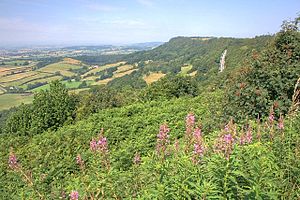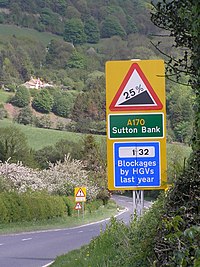Sutton Bank: Difference between revisions
Created page with "{{Infobox hill |name=Sutton Bank |picture=Sutton Bank.jpg |picture caption=The A170 road climbing Sutton Bank |range=Hambleton Hills |os grid ref=SE515815 |latitude=54.238 |lo..." |
No edit summary |
||
| Line 3: | Line 3: | ||
|picture=Sutton Bank.jpg | |picture=Sutton Bank.jpg | ||
|picture caption=The A170 road climbing Sutton Bank | |picture caption=The A170 road climbing Sutton Bank | ||
|county=Yorkshire | |||
|riding=North | |||
|range=Hambleton Hills | |range=Hambleton Hills | ||
|os grid ref=SE515815 | |os grid ref=SE515815 | ||
Latest revision as of 14:14, 10 December 2023
| Sutton Bank | |||
| Yorkshire | |||
|---|---|---|---|
 The A170 road climbing Sutton Bank | |||
| Range: | Hambleton Hills | ||
| Summit: | 978 feet SE515815 54°14’17"N, 1°12’54"W | ||
Sutton Bank is a hill in the Hambleton Hills of the North York Moors in the North Riding of Yorkshire. It is a high point on the Hambleton Hills, with extensive views over the Vale of York and the Vale of Mowbray.
At the foot of Sutton Bank stands the village of Sutton-under-Whitestonecliffe; at 27 letters long, it has the longest hyphenated placename in England.
The A170 road runs down the bank with a maximum gradient of 1 in 4 (25%), and including a hairpin bend. Vehicles have to keep in low gear whilst travelling up or down the bank,[1] and caravans are banned from using the section.

History
Just to the south of Sutton Bank is Roulston Scar, the site of one of the most important prehistoric monuments in the region – a massive hillfort built in the Iron Age, around 400 BC.
This hill was the approximate location of the Battle of Old Byland in which the Scots won a major victory over the English on 14 October 1322. King Robert the Bruce had made a forced march with his army in an attempt to surprise the English army which was retreating from a failed invasion of Scotland. John of Brittany, Earl of Richmond held the heights of Sutton Bank while King Edward II with his Queen had withdrawn to Rievaulx Abbey about fifteen miles to the south-east. The Scots fought their way up the steep hillside to defeat the Earl, whom they took prisoner. King Edward fled ahead of Sir Walter Stewart's forces leaving behind in the Abbey the Great Seal of England and much treasure.[2]
In 1981 a body was found at Sutton Bank. She was never identified and she became known as the Sutton Bank Body.
In 2016 Sutton Bank was included on the route of the third stage of the Tour de Yorkshire cycle race.[3]
Recreation
Because it faces the prevailing westerly winds, Sutton Bank has been used for ridge soaring since the early 1930s for the sport of gliding. The Yorkshire Gliding Club is based at the top of the hill.[4]
Also at the top of the hill is the Sutton Bank National Park Centre, where a high-tech Lime & Ice exhibition tells the story of how the iconic landscape and view came to be through the dramatic action of ice age glaciers. There is also an official tourist information centre, a tea room and a gift shop. Outside, there is a car park, from where pushchair and wheelchair friendly paths leading to a viewing platform, which offers views of Roulston Scar, Hood Hill, Gormire Lake and beyond. There are many legends about Gormire Lake, one of which is that there is a submerged village beneath its waters.[5]
There are many other walking trails close by, including southwards to the popular White Horse of Kilburn. The 110-mile long Cleveland Way National Trail crosses over Sutton Bank. It includes a spur to the White Horse of Kilburn.
The North York Moors National Park Authority has developed new cycle trails, which use a mixture of natural and man-made trails similar to those found in a purpose built trail centre. Using the same style of trail marking, the mountain biking trails available are:
- 'Cliff' - 3 mile green mostly level, circular off-road cycle trail for families that in part follows the famous cliff edge. The trail opened at the end of 2013[6]
- 'Fort' - 9 mile blue trail with 361m ascent/descent (70% stone, 30% natural surface) runs out past the site of the Iron Age fort at Boltby Scar. A shorter loop of 6 miles avoids the ascent/descent and is suitable for families. The Fort route also includes part of the Cliff Trail along the cliff edge.
- 'Paradise' - 17-mile 'red' trail, making use of existing bridleways that have been upgraded but are shared with walkers and horse riders.
There is also a purpose-built bike skills area and a new cycle centre, Sutton Bank Bikes, offers cycle hire, training and skills courses, a bike wash, repair and servicing and a fully stocked cycle shop.
Sutton Bank is an official Dark Sky Discovery Site, one of two in the North York Moors.[7]
Outside links
| ("Wikimedia Commons" has material about Sutton Bank) |
- North York Moors NPA: Suton Bank Visitor Centre
- Sutton Bank Bikes
- Panoramic views from Sutton Bank here and here
References
- ↑ North Yorkshire County Council (24 May 2004). "Safety study for Sutton Bank". Press release. https://www3.northyorks.gov.uk/n2ccpr/2004_/3suttonbank/3suttonbank.pdf. Retrieved 7 September 2010.
- ↑ Scott, Ronald McNair (1989). Robert the Bruce, King of Scots. New York: Peter Bedrick Books. p. 203.
- ↑ "Second day of the Tour de Yorkshire 2016 draws big crowds". 30 April 2016. https://www.bbc.co.uk/news/uk-england-36161788.
- ↑ Yorkshire Gliding Club
- ↑ "Lake Gormire, Sutton Bank". Bradford Telegraph and Argus. http://www.thetelegraphandargus.co.uk/leisure/taleisurewalks/1233120.Lake_Gormire__Sutton_Bank/. Retrieved 13 October 2015.
- ↑ Sutton Bank cycling
- ↑ North York Moors National Park Authority - Dark Skies
